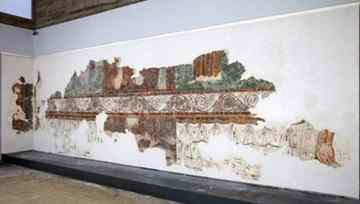Israel Antiquities Authority: This is the largest painting ever to come out of an archaeological excavation in the country.
An enormous impressive wall painting (fresco) that was discovered in excavations by the Israel Antiquities Authority in the Monastery of Miriam in the Gethsemane courtyard in Jerusalem will be displayed for the first time when the renewed Israel Museum opens its doors to the public on July 26, 2010.
 In 1999 the Israel Antiquities Authority conducted salvage excavations in Nahal Kidron, next to the Garden of Gethsemane, under the direction of Jon Seligman, the Jerusalem region archaeologist.
In 1999 the Israel Antiquities Authority conducted salvage excavations in Nahal Kidron, next to the Garden of Gethsemane, under the direction of Jon Seligman, the Jerusalem region archaeologist.
The excavations uncovered several buildings dating to the twelfth century that were part of the Abbey of St. Mary of the Valley of Jehoshaphat, most of which had been destroyed by Saladin.
But to the excavators' surprise a nine meter long wall that was decorated with a painting of breathtaking beauty was exposed in one of the rooms.
Thanks to a generous contribution by the Friends of the Israel Museum, the painting has been restored by a team of art conservators of the Conservation Department of the Israel Antiquities Authority, headed by Jacques Nagar, and will be placed on exhibit in the museum’s new Crusader period gallery.
 According to Seligman, the subject of this wall painting - only the bottom part of which survived and which originally rose to a height of about nine meters - is apparently a scene of deésis (meaning supplication in Greek).
According to Seligman, the subject of this wall painting - only the bottom part of which survived and which originally rose to a height of about nine meters - is apparently a scene of deésis (meaning supplication in Greek).
This is a known iconographic formula whereby Mary and John the Baptist beseech Jesus for forgiveness, for the sake of humanity.
Only the bottom parts of the figures are visible in the main picture: Jesus sitting in the center, with Mary to his right and John the Baptist to his left. Two other pairs of legs, probably those of angels, can be seen next to Mary and John.
In the middle of the painting are colorful floral tendrils on either side of which is a Latin inscription of a saying by Saint Augustine: "Who injures the name of an absent friend, may not at this table as guest attend."
We can conclude from this that the painting adorned the wall of a dining room - the refectorium - in the monastery.
The prohibition to gossip is surprising since the monks there were Benedictines who refrained from unnecessary conversation.
According to the researchers, the maxim was apparently intended for visitors who arrived at the monastery and were invited to dine there.
According to Nagar, "This is one of the most important paintings that have been preserved from the Crusader period in Israel.
The painting is the largest to come out of an archaeological excavation in the country and the treatment the painting underwent in the laboratories of the Israel Antiquities Authority was, from a conservation standpoint, among the most complicated ever done here.
This wall painting is special because of its size and quality. It measures 9 meters long and 2.7 m high, and is extremely rare because very few wall paintings have survived from the Crusader churches that were built in Jerusalem during the Crusader period.
The excellent quality of the painting was in all likelihood the workmanship of master artists and the vibrant colors reflect the importance of the abbey in the twelfth century, which was under the patronage of the Crusader queen Melisende."
"We are proud to include this unique wall painting in our new gallery of Crusader art," said Na'ama Brosh, curator of Islamic art in the Israel Museum and who was responsible for placing it on exhibit in the new gallery. "We wish to thank the Israel Antiquities Authority for their cooperation that has resulted in the presentation of this important exhibit to the public."
Source: Israel Ministry of Foreign Affairs [June 29, 2010]
VIA «12th century Gethsemane fresco to be displayed in Israel Museum»